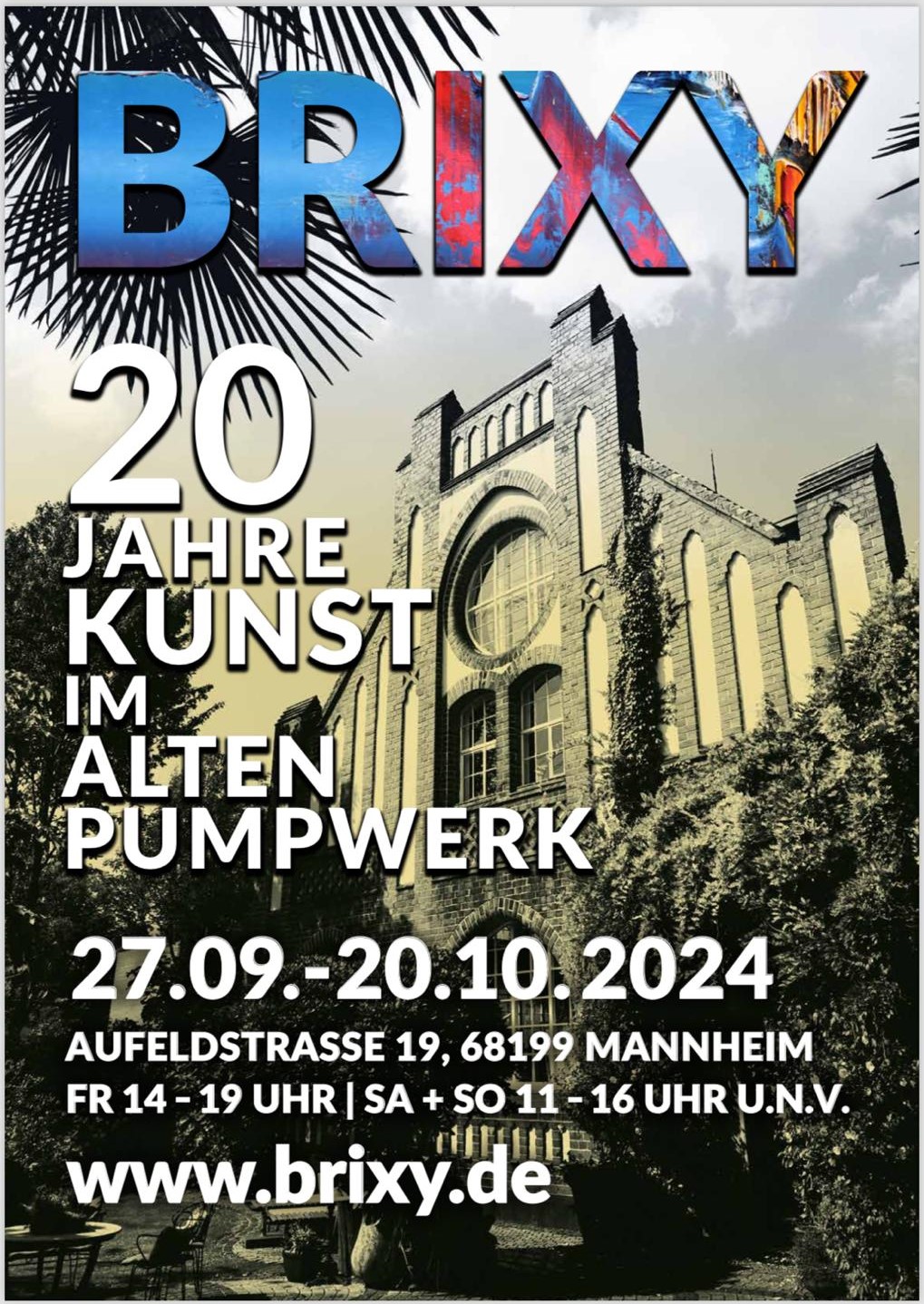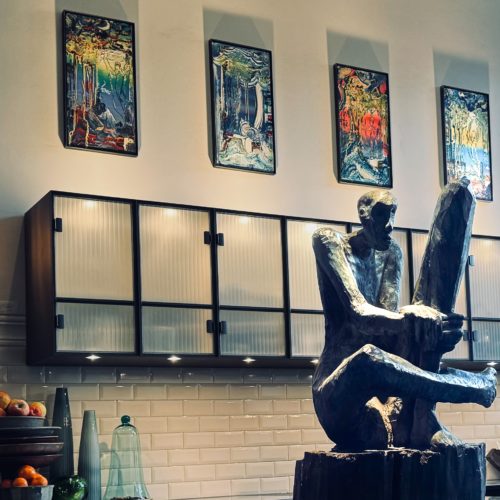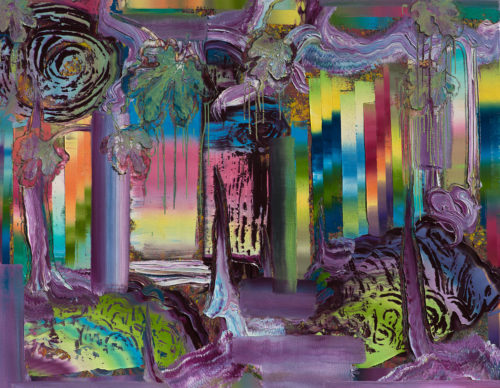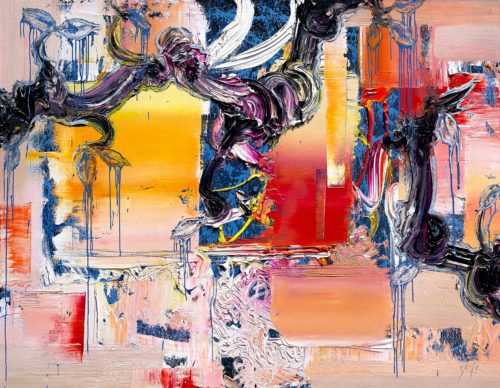This year, the gates of the old pumping station in Mannheim-Neckarau will once again be opened for this year's anniversary exhibition ‘20 years of art in the pumping station’.
Art lovers are invited to take a tour of the Künstlerhaus. Compositions of current works as well as selected works from earlier creative phases of the last 20 years are presented in the interior and exterior space of the industrial monument. The exhibition is complemented by sculptures and works by guest artist Trak Wendisch, whose works are characterised by an intensive exploration of form, colour and space, in cooperation with Galerie Tammen from Berlin. Painting and sculpture enter into an exciting and congenial dialogue here.
The anniversary exhibition is particularly noteworthy as it follows a series of important national and international presentations by Dietmar Brixy. In recent months, his works have already been shown in renowned exhibitions on Sylt, in Berlin and Venice. An edition will be published for the exhibition ‘Brixy - The Description of the World’, which is taking place parallel to the Biennale Arte 2024 in Venice, and will also be presented in the anniversary exhibition at the Altes Pumpwerk. In addition, a new Brixy catalogue, published by the renowned Hirmer Verlag and the ‘Association for Art in Public - Kunststiftung’, will be available at the Altes Pumpwerk.

About the old pumping station
The neo-Gothic clinker brick building was designed according to plans by Richard Perrey (1866-1937), a city planning director from Mannheim who was born in Szczecin, and has a remarkable artistic design. The gable front gives the building a representative character. It is based on motifs from the North German brick Gothic style, whereby the monumental, austere and sober character is reminiscent of Cistercian architecture. The impression of a sacred building is further emphasised by the division into a ‘choir room’ (today's residential building) and a ‘nave’ (today's studio). The sewage treatment plant with two sand traps is located in the front section. The impressive clinker-vaulted sewers flow into these. The rear part is the pump house with the three centrifugal pumps of different sizes (manufacturer: Sulzer Bros., Ludwigshafen), the vacuum pumps and the electric motors. Below this is a vaulted cellar with the suction pipes.
[...] Following the construction of a new wastewater pumping station in the immediate vicinity, the historic building was decommissioned at the end of the 1980s. After long endeavours to find a new use for the building, it was renovated in 2001 in line with its listed status and carefully converted into a residential unit with a studio and collection space for the Mannheim artist Dietmar Brixy.
Dr. Monika Ryll
Lower Monument Protection Authority city of Mannheim
Creative phases & cycles by artist Dietmar Brixy
Brixy mostly works in cycles, after which he titles his paintings. His works rarely have individual titles, but are named after the respective series of works. Some series are not complete and new works are constantly being added. Although the individual cycles build on each other chronologically, they also constantly influence each other anew.
From the very beginning, the line has been a central motif in Brixy's works. As a lifeline, branching branches or even as a horizon. The essence of the line can be interpreted very differently depending on the group of works: as an encounter between two individuals whose paths cross, as an image for setting out - setting off on a journey - or as the crossing of borders. These motifs are particularly pronounced in the avenues from the BEYOND series or in the perspective landscapes in HORIZON. The numerous nature motifs in his paintings have an even stronger recognition value. Intertwined branches dominate the scenes in WEINLESE, ROOTS, GROW, EDEN, DISCOVER, SURPRISE, TOMORROW, ROOM, HAPPY, REFLECT and JOURNEY. The interplay of light and colour creates deep, perspectival levels. Luminous areas of colour form contrasts to sculpturally modelled formations.

Discover, 2014, Öl auf Nessel, 140 x 180 cm
‘Brixy opens up a pictorial event that we perceive from a kind of stage; he takes us by the hand and leads us into a pictorial event blown up to the scale of a panorama. We look from left to right, from top to bottom, stopping briefly to pause at one point in the middle. Faced with this powerful rhythm of color, this colorism taken from nature and its infinite phenomena, all we can do is look on in wonder.’
Dr. Tayfun Belgin
Director Osthaus Museum Hagen, a.D.

Journey, 2023, Öl auf Nessel, 240 x 180 cm
Guest artist Trak Wendisch
Trak Wendisch (actually Trakia René Wendisch) was born in Berlin on 7 August 1958. From 1977 to 1982, he studied at the Academy of Visual Arts in Leipzig under Dietrich Burger and Bernhard Heisig. He has been a freelance artist since 1982 and works as a sculptor, painter and draughtsman. In 1985 he was a master student at the Dresden Academy of Fine Arts under Gerhard Kettner.
Since 1996, his work has been shown in solo and group exhibitions in many German cities as well as in Switzerland, Brazil, the Netherlands and the USA. His works can be found in numerous renowned private and public collections and museums in Germany, Brazil, the Netherlands, Japan and Norway. From 1985 to 1995 he was involved in the joint project Burg Goldbeck. Trak Wendisch lives and works in Berlin.

Tänzerin II, 1991 Bronze, patiniert 205 x 120 x 100 cm
‘Most of his works appear extremely drastic, often like apocalyptic swansongs to the human condition. Wendisch's works also seem to be in the best German expressionist tradition - from the artists of the ‘Brücke’ at the beginning of the 19th century to the East German expressionism of a Heisig, for example, to the neo-expressionism of the ‘Neue Wilde’ in the first half of the 1980s.’
Hans-Michael Herzog
Art historian
Artist Statement Trak Wendisch
Some of the exhibited works were created in the 1990s and some after 2020. So in some cases there are more than thirty years in between. The sculptures were created from various types of wood in the studio in Berlin, at Goldbeck Castle and in Brazil. As wood is not durable outdoors, either in private gardens or in public spaces, the idea of casting selected works in bronze was born in the early 1990s.
The figures you see are ‘fresh’ and newly decided insofar as I re-establish the relationship to the respective sculpture when patinating it myself, making each cast an individual piece. As some of the silicone moulds still exist to this day and I occasionally have another sculpture made, a considerable group of bronzes has been created, which we can show here under wonderful conditions both outdoors and indoors.
As my hosts have also seen my current reliefs in exhibitions and at trade fairs and found them interesting, we decided to present these two formally divergent positions together.
Is there a connection? 30 years is a long time. Nevertheless, I've stayed the same and my approach is the same. The starting point is always the fascination that images, conditions, circumstances, actions etc. trigger, for which I then look for an equivalent form that reflects my desire to work on the object.
That is the connection. Ever since my son dismantled the first PCs thirty years ago and the boards were lying around, I was fascinated by the things. My vague understanding of the function didn't play a role - it was the beauty of the parts that attracted me. They lay around for a long time and multiplied over several generations of development. It's all about the colour, the distribution of components and surfaces, the fineness of the conductor paths on the circuit boards. At some point I just had to start working with them.

Statt XIII, 2023, Mischtechnik auf Wabenplatte
What:
20 years of art in the old pumping station
Where:
Old Pumping Station Mannheim-Neckarau, Aufeldstraße 19, 68199 Mannheim
When:
27 September to 20 October 2024
Opening hours:
Friday 2pm-7pm, Saturday and Sunday 11am-4pm, and Thursday, 03 October 11am-4pm.

























